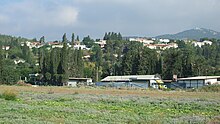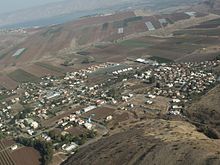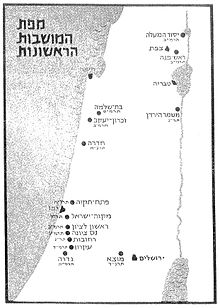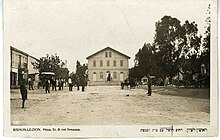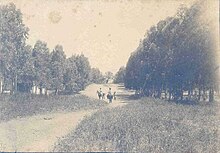
NILI was a Jewish espionage network which assisted the United Kingdom in its fight against the Ottoman Empire in the Mutasarrifate of Jerusalem between 1915 and 1917, during World War I. NILI was centered in Zikhron Ya'akov, with branches in Hadera and other Moshava. Nili is an acronym which stands for the Hebrew phrase from the First Book of Samuel: "Netzah Yisrael Lo Yeshaker", which translates as "the Eternal One of Israel will not lie". The British government code-named NILI the "A Organization", according to a 1920 misfiled memorandum in the British National Archives, as described in the book Spies in Palestine by James Srodes.
This is a partial timeline of Zionism since the start of the 16th century.

Yishuv, HaYishuv HaIvri, or HaYishuv HaYehudi Be'Eretz Yisra'el denotes the body of Jewish residents in Palestine prior to the establishment of the State of Israel in 1948. The term came into use in the 1880s, when there were about 25,000 Jews living in that region, and continued to be used until 1948, by which time there were some 630,000 Jews there. The term is still in use to denote the pre-1948 Jewish residents in Palestine, corresponding to the southern part of Ottoman Syria until 1918, OETA South in 1917–1920, and Mandatory Palestine in 1920–1948.

Zikhron Ya'akov is a town in Israel, 35 kilometres (22 mi) south of Haifa, and part of the Haifa District. It is located at the southern end of the Carmel mountain range overlooking the Mediterranean Sea, near the coastal highway. It was one of the first Jewish settlements of Halutzim in the country, founded in 1882 by Romanian Jews, who in 1883 received support from Baron Edmond James de Rothschild and renamed their town in honor of his father, James Mayer de Rothschild. In 2022 it had a population of 24,145.
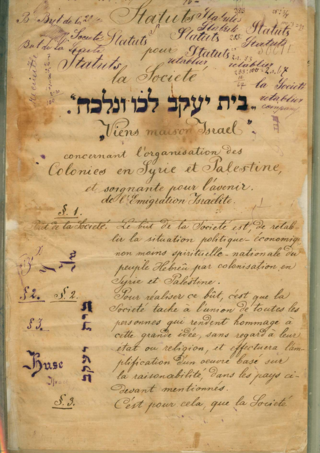
Bilu was a Jewish movement of the late 19th century, fueled predominantly by the immigration of Russian Jews, whose goal was the agricultural settlement of the Land of Israel. Its members were known as Bilu'im, and the movement sought to inspire Jews to migrate to Ottoman Palestine. The Bilu'im rejected progressive notions such as Emancipation and assimilation as viable options for Jewish survival. The movement collapsed as a result of the challenging farming conditions in Palestine and a lack of funding to sustain the settlers.
The Lovers of Zion, also Hovevei Zion or Hibbat Zion, were a variety of proto-Zionist organizations founded in 1881 in response to the anti-Jewish pogroms in the Russian Empire and were officially constituted as a group at a conference led by Leon Pinsker in 1884.
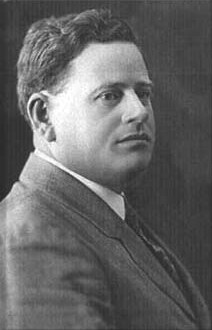
Aaron Aaronsohn was a Romanian-born Ottoman agronomist, botanist, and political activist, who lived most of his life in Ottoman Syria. Aaronsohn was the discoverer of emmer, believed to be "the mother of wheat." He founded and was head of the NILI espionage network.

Rosh Pina or Rosh Pinna is a local council in the Korazim Plateau in the Upper Galilee on the eastern slopes of Mount Kna'an in the Northern District of Israel. It was established as Gei Oni in 1878 by local Jews from Safed but was nearly abandoned, except for the families of Yosef Friedman, Aharon Keller, and possibly a few others. In 1882, thirty Jewish families who had immigrated from Romania reestablished the settlement as a moshava called Rosh Pina. The town is one of the oldest Zionist settlements in Israel. In 2022 it had a population of 3,308.
The First Aliyah, also known as the agriculture Aliyah, was a major wave of Jewish immigration (aliyah) to Ottoman Palestine between 1881 and 1903. Jews who migrated in this wave came mostly from Eastern Europe and from Yemen, stimulated by pogroms and violence against the Jewish communities in those areas. An estimated 25,000 Jews immigrated. Many of the European Jewish immigrants during the late 19th-early 20th century period gave up after a few months and went back to their country of origin, often suffering from hunger and disease.
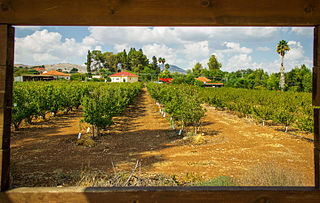
Yesud HaMa'ala is a moshava and local council in northern Israel. The moshava was the first modern Jewish community in the Hula Valley. Built in 1883, the community was among a series of agricultural settlements founded during the First Aliyah. In 2022 it had a population of 1,798.
Carmel Winery is a vineyard and winery in Israel. Founded in 1882 by Edmond James de Rothschild, its products are exported to over 40 countries. It is the largest winery in Israel, with a local market share of almost 50%.

Be'er Tuvia is a moshav in the Southern District of Israel. Located near the city of Kiryat Malakhi, it falls under the jurisdiction of Be'er Tuvia Regional Council. In 2022 its population was 1,313.
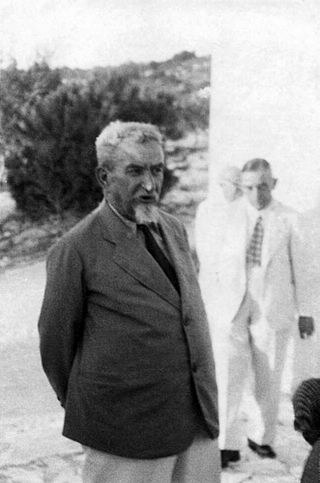
Hillel Yaffe (1864–1936) was a Russian Jewish physician and Zionist leader who immigrated to Palestine during the First Aliyah. He was instrumental in curing malaria among the Jewish population of Palestine in the early 20th century, and helped improve the medical infrastructure of the Yishuv during the same period. The Hillel Yaffe Medical Center in Hadera is named after him.

Mishmar HaYarden was a moshava that was established in the Upper Galilee in northern Israel during the First Aliyah. It was destroyed during the 1948 Arab–Israeli war in 1948. Its Hebrew name meant Guardian of the Jordan. The village was re-established as new Mishmar HaYarden.

Yavne'el is a moshava and local council in the Northern District of Israel. Founded in 1901, it is one of the oldest rural Jewish communities in the country. According to the Israel Central Bureau of Statistics (CBS), in 2022 it had a population of 4,542. In 2008 the population had been 3,100, with a growth rate of 1.4%.
The Old Yishuv were the Jewish communities of the region of Palestine during the Ottoman period, up to the onset of Zionist aliyah waves, and the consolidation of the New Yishuv by the end of World War I. Unlike the New Yishuv, characterized by secular and Zionist ideologies promoting labor and self-sufficiency, the Old Yishuv primarily consisted of religious Jews who relied on external donations (halukka) for support.
Hitahdut HaIkarim is a settlement movement for private farmers in Israel.

Mahanayim is a kibbutz in northern Israel. Located in the Korazim Plateau, around three kilometres northeast of Rosh Pinna, it falls under the jurisdiction of Upper Galilee Regional Council. In 2022 it had a population of 798.
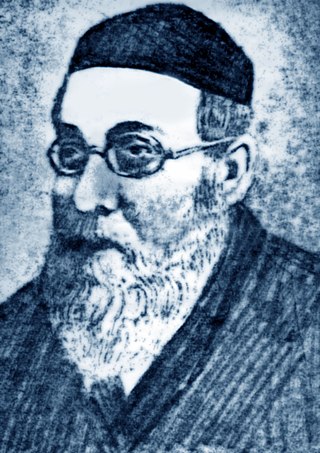
Yosef Yitzhak "Yoshya" Rivlin was an Orthodox Jewish scholar, writer, and community leader in the Old Yishuv of Jerusalem. Scion of a family of Perushim, disciples of the Vilna Gaon who immigrated to Israel in the early 19th century, Rivlin spearheaded the establishment of the first Jewish neighborhoods outside the Old City walls. He helped found a total of 13 neighborhoods, beginning with Nahalat Shiv'a and Mea Shearim. His activities earned him the nickname Shtetlmacher ("Town-Maker"). He directed the Central Committee of Knesseth Israel, the supreme council of the Ashkenazi community in the Old Yishuv, for over 30 years.
Municipal elections took place in Israel on 31 December 1973, having been delayed from their original date on 30 October because of the Yom Kippur War. They were the last municipal elections to take place on the date of a legislative election, and the first in which the newly formed Likud participated.

